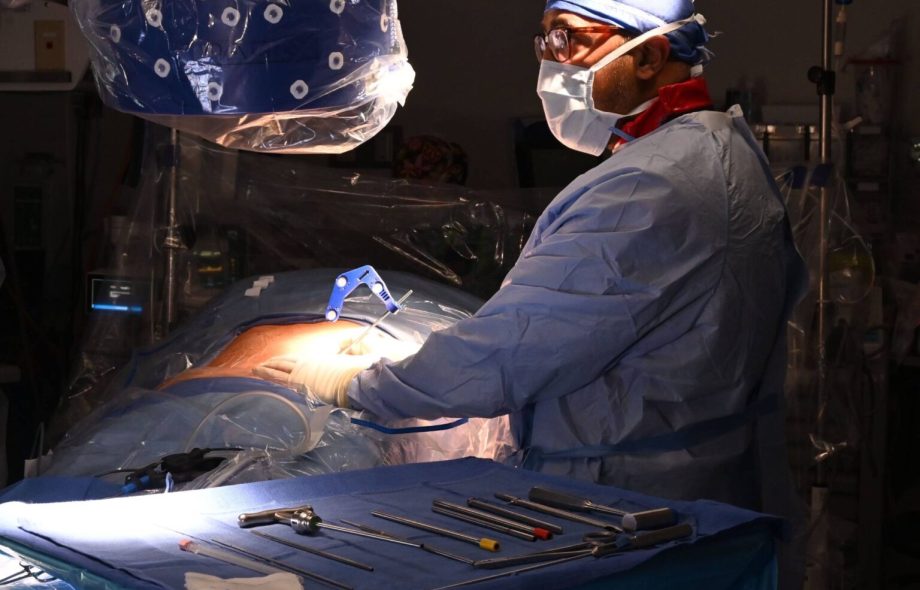Scoliosis, a condition characterized by an abnormal sideways curvature of the spine, affects millions worldwide. While many cases are mild and managed with observation or bracing, severe or rapidly progressing curves can sometimes necessitate surgical intervention. Traditionally, surgical correction for scoliosis has involved extensive open procedures. However, advancements in surgical techniques have introduced a less invasive approach: minimally invasive spine surgery (MISS) for scoliosis.
This article delves into what minimally invasive spine surgery for scoliosis entails, exploring its benefits, limitations, and who might be a candidate for this advanced treatment option.
Understanding Scoliosis and the Need for Surgery
Before discussing minimally invasive approaches, it’s important to understand scoliosis itself. The spine naturally has curves when viewed from the side (kyphosis and lordosis), but it should appear straight when viewed from the front or back. Scoliosis causes the spine to curve laterally, often forming a “C” or “S” shape, and can also involve a rotational component, causing ribs or vertebrae to twist.
The most common type, Idiopathic Scoliosis, has no known cause and often develops during the growth spurt just before puberty (Adolescent Idiopathic Scoliosis). While mild curves usually don’t cause significant problems, larger curves (typically exceeding 40-50 degrees) can progress even after skeletal maturity. Severe scoliosis can lead to back pain, uneven shoulders or hips, a prominent rib hump, and in very severe cases, even respiratory issues due to reduced lung space.
Surgery is typically recommended for significant curves that are progressing or have reached a threshold where future problems are highly likely. The primary goals of scoliosis surgery are to stop the curve’s progression, reduce the existing curve, and stabilize the spine.
The Traditional Approach: Open Scoliosis Surgery
For decades, the gold standard for surgically correcting severe scoliosis has been open spinal fusion. This involves a long incision down the back, extensive dissection of muscles to expose the spine, placement of screws, hooks, or wires into the vertebrae, and connecting these via rods to realign the spine. Bone graft material is then placed around the instrumented segments to encourage the vertebrae to fuse together into a single, solid bone over several months.
Open surgery is effective at achieving significant curve correction and stability. However, it inherently involves substantial muscle disruption, which contributes to significant post-operative pain, blood loss, longer hospital stays, and a protracted recovery period. The large incision also results in a prominent scar.
Introducing Minimally Invasive Spine Surgery (MISS) for Scoliosis
Minimally invasive spine surgery for scoliosis represents a significant evolution in surgical technique. Unlike the large, open incision, MISS utilizes several smaller incisions, often only 1-2 centimeters each. Through these smaller openings, surgeons use specialized instruments, microscopic cameras (endoscopes), and advanced navigation systems (like fluoroscopy or 3D imaging) to access the spine segments requiring treatment.
The core principle of MISS is to work between muscles rather than cutting through them. This can be achieved using techniques like:
- Tubular Retractors: Small tubes are inserted through the skin and muscle, gently dilating the muscle fibers to create a working channel down to the spine.
- Percutaneous Instrumentation: Screws and rods are placed through tiny skin punctures without wide muscle dissection.
The goal of minimally invasive spine surgery for scoliosis is similar to open surgery often spinal fusion using instrumentation (screws and rods) and bone graft to correct the curve and achieve long-term stability. However, by minimizing tissue trauma, MISS aims to reduce many of the drawbacks associated with the open approach.
Who is a Candidate for Minimally Invasive Spine Surgery for Scoliosis?
It’s crucial to understand that minimally invasive spine surgery for scoliosis is not suitable for every patient or every type of scoliosis. Candidate selection is highly individualized and depends on several factors:
- Curve Type and Complexity: MISS is often more applicable to certain curve patterns, such as single, main thoracic or thoracolumbar curves that are relatively flexible. Very large, stiff, or complex “S” shaped curves with multiple curves may still require an open approach to achieve adequate correction.
- Patient Anatomy: Factors like body habitus, previous surgeries, and the specific anatomy of the patient’s spine can influence feasibility.
- Patient Health: While MISS can sometimes be beneficial for patients with certain medical conditions, it’s still major surgery, and overall health is assessed.
- Surgeon Expertise: Minimally invasive spine surgery for scoliosis is technically demanding and requires specialized training and experience. The surgeon’s proficiency in MISS techniques is a critical factor.
- Curve Rigidity: Very stiff curves may require more aggressive manipulation than is easily achievable through minimal access portals.
A spine surgeon experienced in both open and minimally invasive techniques will thoroughly evaluate the patient’s condition, imaging studies (X-rays, MRI, CT scans), and overall health to determine the optimal surgical strategy.
The MISS Procedure for Scoliosis: A General Overview
While specific techniques vary, a typical minimally invasive spine surgery for scoliosis procedure might involve:
- Anesthesia: General anesthesia is administered. The patient is positioned appropriately (usually face down).
- Planning & Incisions: Using pre-operative imaging and real-time guidance (fluoroscopy or navigation), the surgeon plans the placement of hardware and determines the locations for small incisions.
- Access: Small incisions are made, and dilators and tubular retractors are inserted to create working channels down to the spine at each level where screws or other instruments will be placed. Alternatively, screws may be placed percutaneously (through the skin) using guide wires.
- Instrumentation: Screws are carefully inserted into the vertebrae through the working channels or percutaneous tracts. Advanced guidance systems help ensure precise placement, avoiding nerve structures.
- Rod Placement and Correction: Specialized rods, sometimes pre-bent, are introduced through separate small incisions or guided through the channels. Techniques are used to attach the rods to the screws and apply corrective forces to reduce the curve. This is often done segment by segment.
- Fusion: Bone graft material is placed around the spine segments intended for fusion, often delivered through the working channels.
- Closure: Once the correction is achieved and hardware is secured, the instruments are removed, and the small incisions are closed with sutures or staples, often resulting in less noticeable scars compared to open surgery.
Benefits of Minimally Invasive Spine Surgery for Scoliosis
Compared to traditional open scoliosis surgery, MISS offers several potential advantages:
- Reduced Muscle Trauma: By avoiding large incisions and muscle dissection, MISS preserves more of the muscles surrounding the spine, which are vital for stability and function.
- Smaller Incisions and Less Scarring: The cosmetic outcome is often preferred due to multiple small cuts instead of one long one.
- Less Blood Loss: Minimizing tissue dissection generally leads to less bleeding during the procedure.
- Reduced Post-operative Pain: Less muscle and tissue damage typically translates to less pain after surgery, potentially requiring less opioid pain medication.
- Potentially Shorter Hospital Stay: Patients may be able to leave the hospital sooner than those undergoing open surgery.
- Faster Recovery: Reduced pain and muscle trauma can facilitate an earlier return to daily activities, school, or work, although the spine still needs time to fuse.
Potential Risks and Limitations
Despite its benefits, minimally invasive spine surgery for scoliosis is still a complex major surgery carrying inherent risks, similar to open procedures:
- General Surgical Risks: Infection, excessive bleeding, blood clots, and reactions to anesthesia.
- Spine-Specific Risks: Nerve damage (potentially leading to pain, numbness, weakness, or paralysis), damage to the spinal cord, hardware failure (screws or rods breaking or loosening), pseudoarthrosis (failure of the bones to fuse).
- Limitations: As mentioned, MISS may not be suitable for all curve types or severities. Achieving the same degree of correction as an aggressive open procedure can sometimes be more challenging in certain cases, although techniques are constantly improving. The procedure can also sometimes take longer than open surgery, particularly in the earlier stages of a surgeon’s learning curve.
Recovery and Rehabilitation
Recovery from minimally invasive spine surgery for scoliosis is generally faster and less painful than from open surgery, but it is still a gradual process.
- Hospital Stay: Typically ranges from a few days to about a week, depending on the extent of the surgery and the patient’s recovery progress.
- Pain Management: Pain is managed with medication, but often less is required compared to open surgery.
- Mobility: Patients are usually encouraged to get out of bed and walk soon after surgery to aid recovery.
- Restrictions: Activity restrictions, such as avoiding bending, lifting heavy objects, and twisting the spine, are necessary for several months to allow the fusion to heal.
- Bracing: Some surgeons may recommend a brace for a period to support the spine during the fusion process, though this varies.
- Physical Therapy: Rehabilitation is crucial to regain strength, flexibility, and mobility.
- Return to Activities: Return to school or a sedentary job might be possible within a few weeks, while returning to sports and strenuous activities generally takes several months (typically 6-12 months), depending on the fusion progress and the surgeon’s recommendations.
Conclusion: Is MISS Right for You?
Minimally invasive spine surgery for scoliosis represents a significant advancement, offering the potential benefits of reduced pain, less scarring, and faster recovery for selected patients with certain types of spinal curvature. By preserving more of the surrounding muscle tissue compared to traditional open techniques, it minimizes surgical trauma while still aiming to achieve effective curve correction and fusion.
However, it is not a universal solution. The decision to pursue minimally invasive spine surgery for scoliosis versus a traditional open approach depends heavily on the individual patient’s condition, the characteristics of their scoliosis, and the assessment by a qualified spine surgeon.
If you or a loved one are exploring surgical options for scoliosis, it is vital to consult with a spine surgeon who has expertise in both open and minimally invasive techniques. They can provide a comprehensive evaluation, discuss the risks and benefits of each approach as they apply to your specific case, and help you make an informed decision about the best path forward to address your scoliosis. As techniques continue to evolve, MISS promises to play an increasing role in the surgical management of spinal deformities.
 :
https://johnasgharmd.com/minimally-invasive/
:
https://johnasgharmd.com/minimally-invasive/

